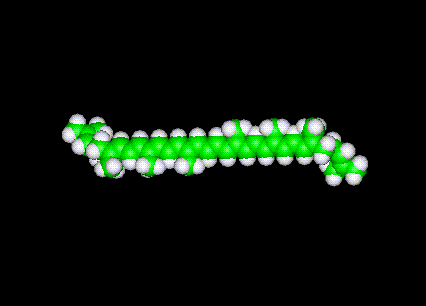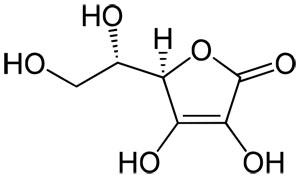Lycopene Molecule

Image: Lycopene molecule
To View the lycopene in 3D --->> with Jsmol
Lycopene has the chemical formula C40H56 and a molecular mass of 536.888 g/mol. Vitamin C is purely the L-enantiomer of ascorbate; the opposite D-enantiomer has no physiological significance. Both forms are mirror images of the same molecular structure.
Molecular Struture
Lycopene is a linear, unsaturated hydrocarbon carotenoid, the major red pigment in fruits such as tomatoes, pink grapefruit, apricots, red oranges, watermelon, rosehips, and guava. As a class, carotenoids are pigment compounds found in photosynthetic organisms (plants, algae, and some types of fungus), and are chemically characterized by a large polyene chain containing 35-40 carbon atoms; some carotenoid polyene chains are terminated by two 6-carbon rings. In animals, carotenoids such as lycopene may possess antioxidant properties which may retard aging and many degenerative diseases. As an essential nutrient, lycopene is required in the animal diet
 Lycopene Molecular Structure
Lycopene Molecular Structure
Lycopene is one of over 600 phytochemicals called carotenoids with very powerful disease-fighting capabilities, particularly against prostate cancer. Lycopene is a bright red carotenoid pigment found in tomatoes. The name is derived from the tomato's species classification, Lycopersicum lycopersicum. Tomato-based products such as tomato sauce, tomato soup, and tomato juice have the most concentrated source of lycopene. Cooked tomato sauces are associated with greater health benefits, compared to uncooked, because the heating process makes lycopene more easily absorbed by the body. Also, lycopene is fat-soluble, meaning that in order for the body to absorb it, it has to be eaten with at least a small amount of fat. Lycopene has been associated with a reduced risk for many cancers and protection against heart attacks, though research continues on other potential health benefits.
Lycopene (shown below) has an open ring structure not the closed ionone ring found in beta carotene.
![]()
Lycopene, being naturally so prevalent in a common foodstuff, has been licensed for use as a food additive. Its approved use is as a food colouring, though research has shown that it is also a powerful antioxidant, with possibly beneficial effects on health.
Abstract: An Update on the Health Effects of Tomato Lycopene
"...Lycopene is a non-provitamin A carotenoid that is responsible for the red to pink colors seen in tomatoes, pink grapefruit, and other foods. Processed tomato products are the primary dietary lycopene source in the United States. Unlike many other natural compounds, lycopene is generally stable to processing when present in the plant tissue matrix. Recently, lycopene has also been studied in relation to its potential health effects. Although promising data from epidemiological, as well as cell culture and animal, studies suggest that lycopene and the consumption of lycopene containing foods may affect cancer or cardiovascular disease risk, more clinical trial data is needed to support this hypothesis. In addition, future studies are required to understand the mechanism(s) whereby lycopene or its metabolites are proven to possess biological activity in humans..."
Antioxidant Molecules
- Astaxanthin
- Ellagic Acid
- Picrocrocin
- Lycopene
- Lutein/Zeaxanthin
- Quercetin
- Vitamin C
- IP-6
- Beta-Carotene
- Epicatechin
- ECGC- Epigallocatechin gallate
- Safranal
- Proanthocyanidins
- Resveratrol
- Vitamin E
- Melatonin
- MitoQ
Molecules of Life Resources